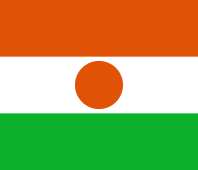Flag of Niger facts for kids
 |
|
| Use | National flag |
|---|---|
| Proportion | 6:7 (see below) |
| Adopted | 23 November 1959 |
| Design | A horizontal triband of orange, white and green; charged with an orange circle in the centre |
The flag of Niger is an important national symbol. It was officially adopted on 23 November 1959. This happened just before Niger became fully independent from France. The flag's design tells a story about the country's land, people, and hopes for the future.
Contents
What Does the Flag of Niger Look Like?
The flag of Niger has three equal horizontal stripes. These stripes are orange, white, and green. In the very center of the white stripe, there is a bright orange circle. This simple design is full of meaning for the people of Niger.
The Meaning Behind the Colors
Each color on the flag represents something special about Niger:
- Orange: This color stands for the Sahara Desert. The desert covers a large part of northern Niger. It also represents the dry savanna areas in the country.
- White: The white stripe symbolizes purity and innocence. It also represents the Niger River, which is a vital source of life and water for the country.
- Green: This color shows the fertile plains and agricultural areas in the south of Niger. It also represents hope for a bright future and the country's rich natural resources.
The Orange Circle
The orange circle in the middle of the flag is very important. It represents the sun. The sun is a symbol of the country's independence and its bright future. It also reminds people of the sun's warmth and the importance of life in a hot climate.
When Was the Flag Adopted?
Niger adopted its flag on 23 November 1959. At this time, Niger was still a self-governing republic within the French Community. The flag was chosen to represent the nation as it moved towards full independence. This official adoption happened almost a year before Niger gained complete independence on 3 August 1960.
Images for kids
See also
 In Spanish: Bandera de Níger para niños
In Spanish: Bandera de Níger para niños


